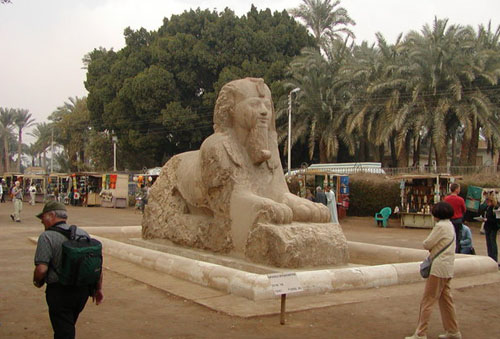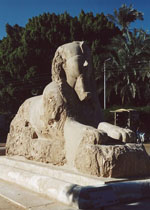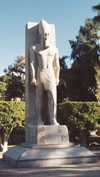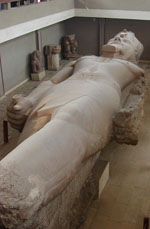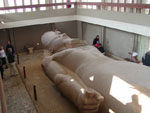|
Memphis
was the ancient
capital of Egypt, from its foundation 3100 BC until around 2200 BC
and later for shorter periods during the New Kingdom, and an
administrative centre throughout ancient history.

Its Ancient Egyptian name was Ineb
Hedj ("The White Walls"). The name "Memphis" is the Greek
deformation of the Egyptian name of Pepi I's (6th dynasty) pyramid,
Men-nefer, which became Menfe in Coptic. The modern cities and towns
of Mit Rahina, Dahshur, Saqqara, Abusir, Abu Gorab, and Zawyet
el'Aryan, south of Cairo, all lie within the administrative borders
of historical Memphis.
Memphis was also known in Ancient Egypt as Ankh Tawy ("That which
binds the Two Lands"), thus stressing the strategic position of the
city between Upper and Lower Egypt.
The ruins of Memphis are 30 km south of Cairo, on the west bank of
the Nile.
According to Herodotus, the city was founded around 3100 BC by
Menes, who united the two kingdoms of Egypt.
It has also been established that King Menes was most likely just a
mythical king similar to that of Romulus and Remus the mythical
first rulers of Rome, most likely Egypt became unified through
mutual need, developing cultural ties over time and trading
partnerships though it is still understood that the first capital of
Ancient Egypt was the lower Egyptian city of Memphis. The story most
likely just got passed on to Herodotus.
Estimates of population size differ widely. According to T. Chandler
Memphis had some 30,000 inhabitants and was by far the largest
settlement worldwide from the time of its foundation until around
2250 BC and from 1557 to 1400 BC. K. A. Bard is more cautious and
estimates the city's population to have amounted to about 6,000
inhabitants during the Old Kingdom.
Memphis reached a peak of prestige under the 6th Dynasty as a centre
of the cult of Ptah. It declined briefly after the 18th Dynasty with
the rise of Thebes and was revived under the Persian satraps before
falling firmly into second place following the foundation of
Alexandria. Under the Roman Empire, Alexandria remained the most
important city. Memphis remained the second city of Egypt until the
establishment of Fustat (or Fostat) in 641. It was then largely
abandoned and became a source of stone for the surrounding
settlements. It was still an imposing set of ruins in the 12th
century but soon became little more than an expanse of low ruins and
scattered stone.
The remains of the temple of Ptah and of Apis have been uncovered at
the site as well as a few statues, including two four-meter ones in
alabaster of Ramses II. The Saqqara necropolis is close to Memphis.
The Egyptian historian Manetho referred to Memphis as Hi-Ku-Ptah
("Place of the Ka of Ptah"), which he wrote in Greek as Aί γυ πτoς
(Ai-gu-ptos), giving us the Latin AEGYPTVS and the modern English
Egypt. The term Copt is also believed to be etymologically derived
from this name.
In the Bible, Memphis is called Moph or Noph.
|

